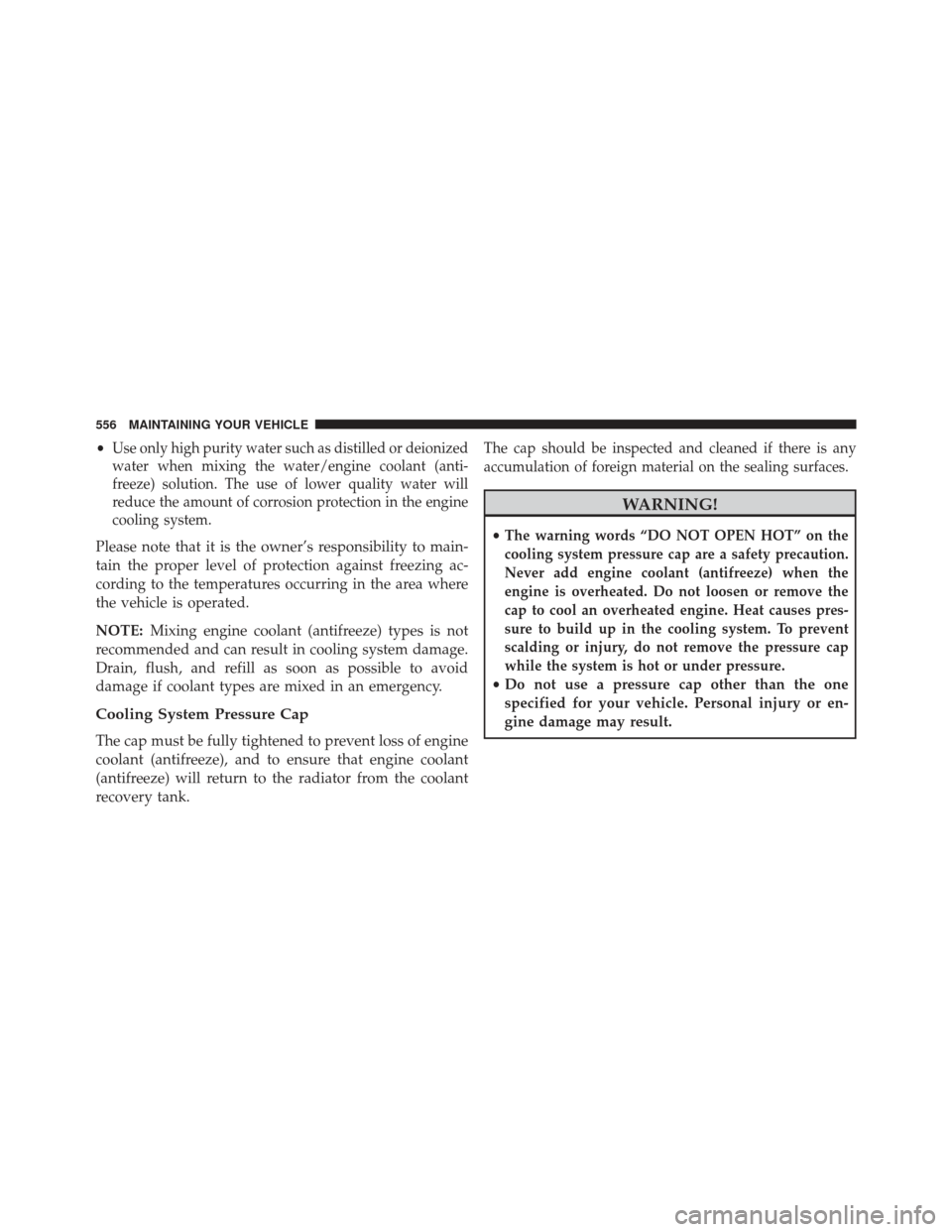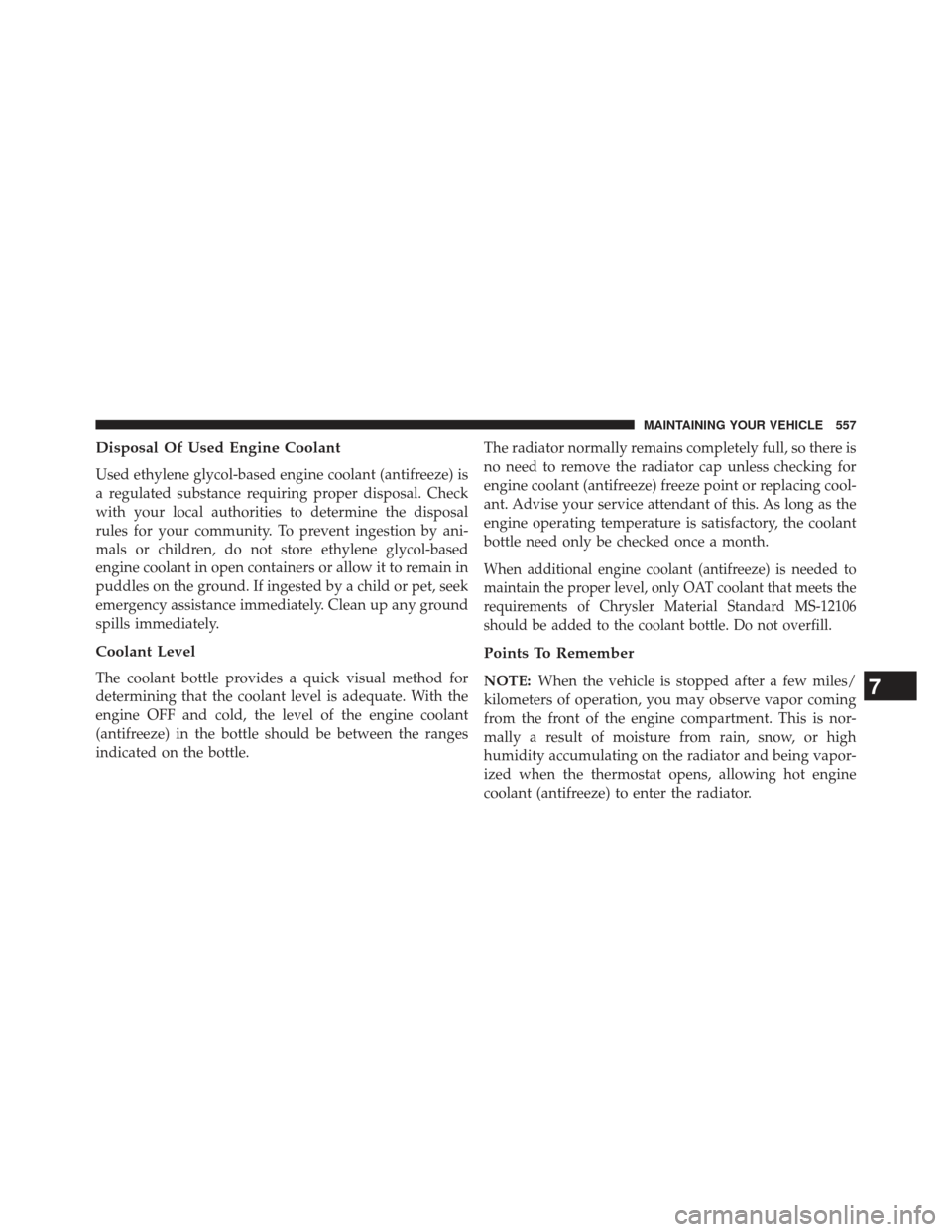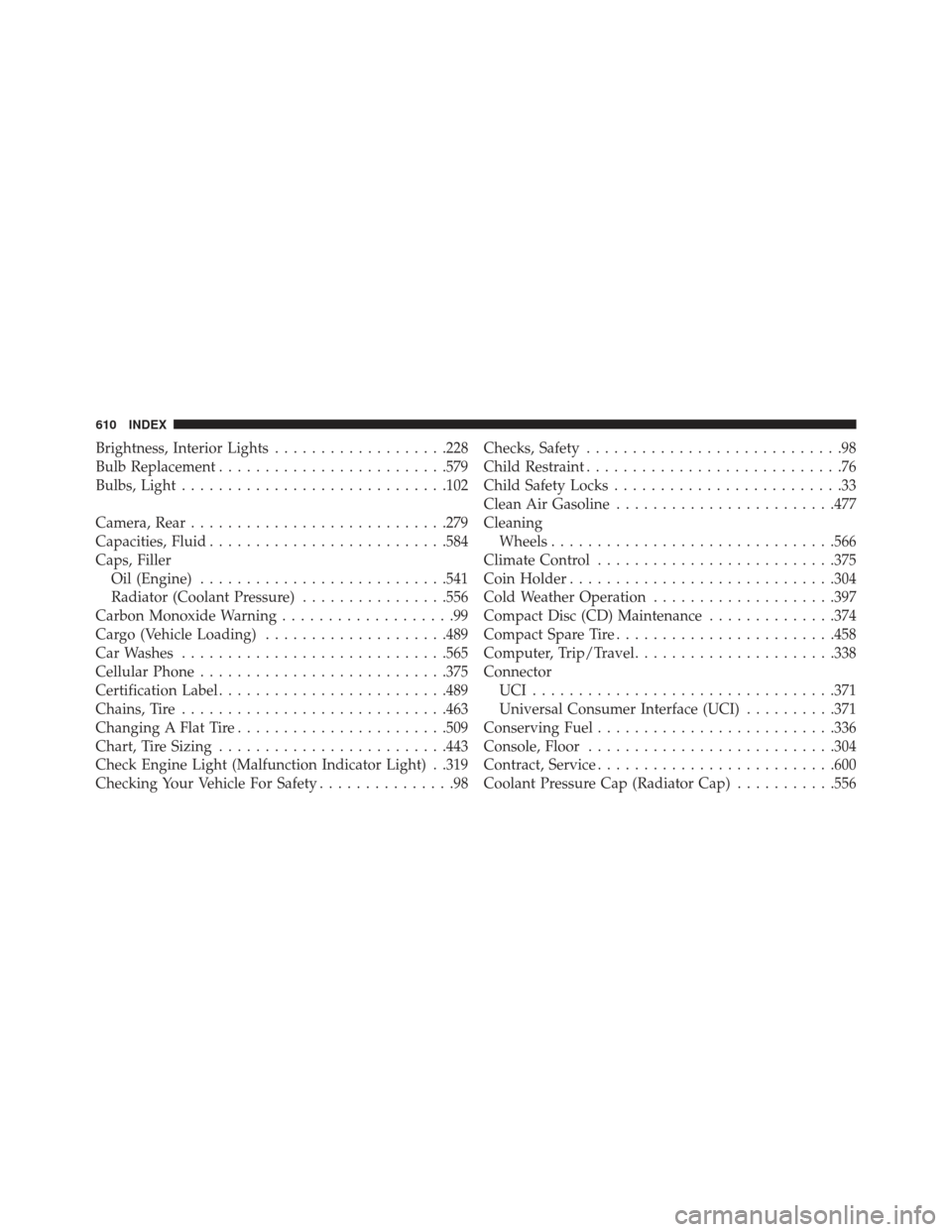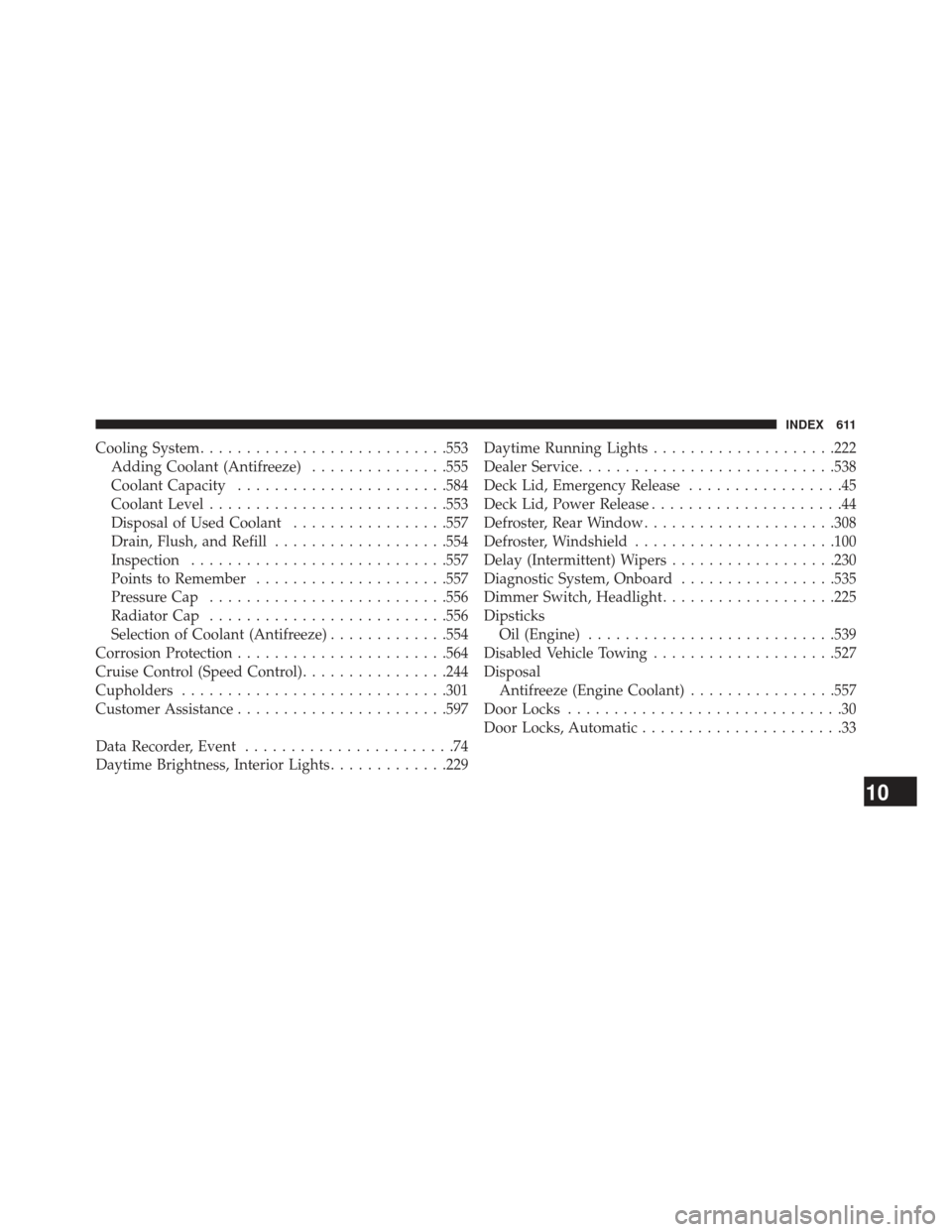2013 DODGE CHARGER radiator cap
[x] Cancel search: radiator capPage 511 of 631

CAUTION!
Driving with a hot cooling system could damage
your vehicle. If the temperature gauge reads “H,”
pull over and stop the vehicle. Idle the vehicle with
the air conditioner turned off until the pointer drops
back into the normal range. If the pointer remains on
the “H,” turn the engine off immediately and call for
service.
WARNING!
You or others can be badly burned by hot engine
coolant (antifreeze) or steam from your radiator. If
you see or hear steam coming from under the hood,
do not open the hood until the radiator has had time
to cool. Never try to open a cooling system pressure
cap when the radiator or coolant bottle is hot.
JACKING AND TIRE CHANGING
WARNING!
•Do not attempt to change a tire on the side of the
vehicle close to moving traffic. Pull far enough off
the road to avoid the danger of being hit when
operating the jack or changing the wheel.
• Being under a jacked-up vehicle is dangerous. The
vehicle could slip off the jack and fall on you. You
could be crushed. Never put any part of your body
under a vehicle that is on a jack. If you need to get
under a raised vehicle, take it to a service center
where it can be raised on a lift.
• Never start or run the engine while the vehicle is
on a jack.
(Continued)
6
WHAT TO DO IN EMERGENCIES 509
Page 555 of 631

Cooling System
WARNING!
•When working near the radiator cooling fan, dis-
connect the fan motor lead or turn the ignition
switch to the LOCK position. The fan is tempera-
ture controlled and can start at any time the igni-
tion switch is in the ON position.
• You or others can be badly burned by hot engine
coolant (antifreeze) or steam from your radiator. If
you see or hear steam coming from under the hood,
do not open the hood until the radiator has had
time to cool. Never try to open a cooling system
pressure cap when the radiator is hot.
Coolant Checks
Check engine coolant (antifreeze) protection every
12 months (before the onset of freezing weather, where
applicable). If the engine coolant (antifreeze) is dirty or
rusty in appearance, the system should be drained,
flushed, and refilled with fresh coolant. Check the front
of the radiator for any accumulation of bugs, leaves, etc.
If dirty, clean by gently spraying water from a garden
hose vertically down the face of the condenser.
Check the coolant recovery bottle tubing for brittle rubber,
cracking, tears, cuts, and tightness of the connection at the
bottle and radiator. Inspect the entire system for leaks.
With the engine at normal operating temperature (but
not running), check the cooling system pressure cap for
proper vacuum sealing by draining a small amount of
engine coolant (antifreeze) from the radiator drain cock.7
MAINTAINING YOUR VEHICLE 553
Page 558 of 631

•Use only high purity water such as distilled or deionized
water when mixing the water/engine coolant (anti-
freeze) solution. The use of lower quality water will
reduce the amount of corrosion protection in the engine
cooling system.
Please note that it is the owner’s responsibility to main-
tain the proper level of protection against freezing ac-
cording to the temperatures occurring in the area where
the vehicle is operated.
NOTE: Mixing engine coolant (antifreeze) types is not
recommended and can result in cooling system damage.
Drain, flush, and refill as soon as possible to avoid
damage if coolant types are mixed in an emergency.
Cooling System Pressure Cap
The cap must be fully tightened to prevent loss of engine
coolant (antifreeze), and to ensure that engine coolant
(antifreeze) will return to the radiator from the coolant
recovery tank.
The cap should be inspected and cleaned if there is any
accumulation of foreign material on the sealing surfaces.
WARNING!
•The warning words “DO NOT OPEN HOT” on the
cooling system pressure cap are a safety precaution.
Never add engine coolant (antifreeze) when the
engine is overheated. Do not loosen or remove the
cap to cool an overheated engine. Heat causes pres-
sure to build up in the cooling system. To prevent
scalding or injury, do not remove the pressure cap
while the system is hot or under pressure.
• Do not use a pressure cap other than the one
specified for your vehicle. Personal injury or en-
gine damage may result.
556 MAINTAINING YOUR VEHICLE
Page 559 of 631

Disposal Of Used Engine Coolant
Used ethylene glycol-based engine coolant (antifreeze) is
a regulated substance requiring proper disposal. Check
with your local authorities to determine the disposal
rules for your community. To prevent ingestion by ani-
mals or children, do not store ethylene glycol-based
engine coolant in open containers or allow it to remain in
puddles on the ground. If ingested by a child or pet, seek
emergency assistance immediately. Clean up any ground
spills immediately.
Coolant Level
The coolant bottle provides a quick visual method for
determining that the coolant level is adequate. With the
engine OFF and cold, the level of the engine coolant
(antifreeze) in the bottle should be between the ranges
indicated on the bottle.The radiator normally remains completely full, so there is
no need to remove the radiator cap unless checking for
engine coolant (antifreeze) freeze point or replacing cool-
ant. Advise your service attendant of this. As long as the
engine operating temperature is satisfactory, the coolant
bottle need only be checked once a month.
When additional engine coolant (antifreeze) is needed to
maintain the proper level, only OAT coolant that meets the
requirements of Chrysler Material Standard MS-12106
should be added to the coolant bottle. Do not overfill.
Points To Remember
NOTE:
When the vehicle is stopped after a few miles/
kilometers of operation, you may observe vapor coming
from the front of the engine compartment. This is nor-
mally a result of moisture from rain, snow, or high
humidity accumulating on the radiator and being vapor-
ized when the thermostat opens, allowing hot engine
coolant (antifreeze) to enter the radiator.7
MAINTAINING YOUR VEHICLE 557
Page 612 of 631

Brightness, Interior Lights...................228
Bulb Replacement ........................ .579
Bulbs, Light ............................ .102
Camera, Rear ........................... .279
Capacities, Fluid ......................... .584
Caps, Filler Oil (Engine) .......................... .541
Radiator (Coolant Pressure) ................556
Carbon Monoxide Warning ...................99
Cargo (Vehicle Loading) ....................489
Car Washes ............................ .565
Cellular Phone .......................... .375
Certification Label ........................ .489
Chains, Tire ............................ .463
Changing A Flat Tire ...................... .509
Chart, Tire Sizing ........................ .443
Check Engine Light (Malfunction Indicator Light) . .319
Checking Your Vehicle For Safety ...............98Checks, Safety
............................98
Child Restraint ............................76
Child Safety Locks .........................33
Clean Air Gasoline ....................... .477
Cleaning Wheels .............................. .566
Climate Control ......................... .375
Coin Holder ............................ .304
Cold Weather Operation ....................397
Compact Disc (CD) Maintenance ..............374
Compact Spare Tire ....................... .458
Computer, Trip/Travel ..................... .338
Connector UCI................................ .371
Universal Consumer Interface (UCI) ..........371
Conserving Fuel ......................... .336
Console, Floor .......................... .304
Contract, Service ......................... .600
Coolant Pressure Cap (Radiator Cap) ...........556
610 INDEX
Page 613 of 631

Cooling System.......................... .553
Adding Coolant (Antifreeze) ...............555
Coolant Capacity ...................... .584
Coolant Level ......................... .553
Disposal of Used Coolant .................557
Drain, Flush, and Refill ...................554
Inspection ........................... .557
Points to Remember .....................557
Pressure Cap ......................... .556
Radiator Cap ......................... .556
Selection of Coolant (Antifreeze) .............554
Corrosion Protection ...................... .564
Cruise Control (Speed Control) ................244
Cupholders ............................ .301
Customer Assistance ...................... .597
Data Recorder, Event .......................74
Daytime Brightness, Interior Lights .............229Daytime Running Lights
....................222
Dealer Service ........................... .538
Deck Lid, Emergency Release .................45
Deck Lid, Power Release .....................44
Defroster, Rear Window .....................308
Defroster, Windshield ..................... .100
Delay (Intermittent) Wipers ..................230
Diagnostic System, Onboard .................535
Dimmer Switch, Headlight ...................225
Dipsticks Oil (Engine) .......................... .539
Disabled Vehicle Towing ....................527
Disposal Antifreeze (Engine Coolant) ................557
Door Locks ..............................30
Door Locks, Automatic ......................33
10
INDEX 611
Page 623 of 631

PretensionersSeat Belts ..............................57
Programming Transmitters (Remote Keyless Entry) . .21
Radial Ply Tires ......................... .455
Radiator Cap (Coolant Pressure Cap) ...........556
Radio Operation ......................... .375
Radio Remote Controls .....................372
Rain Sensitive Wiper System .................232
Rear Axle (Differential) .....................563
Rear Camera ........................... .279
Rear Cupholder ......................... .303
Rear Park Sense System .....................271
Rear Seat, Folding ........................ .212
Rear Window Defroster .....................308
Rear Window Features .....................308
Recorder, Event Data .......................74
Recreational Towing ...................... .505
Reformulated Gasoline .....................477 Refrigerant
............................. .547
Reminder, Lights On ...................... .223
Reminder, Seat Belt .........................58
Remote Control Starting System .........................27
Remote Keyless Entry (RKE) ..................21
Remote Sound System (Radio) Controls .........372
Remote Starting System ......................27
Remote Trunk Release .......................44
Replacement Bulbs ....................... .579
Replacement Keys .........................17
Replacement Parts ........................ .537
Replacement Tires ........................ .461
Reporting Safety Defects ....................601
Resetting Oil Change Indicator ................317
Restraint, Head .......................... .209
Restraints, Child ...........................76
Restraints, Occupant ........................46
10
INDEX 621